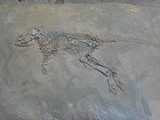
Macrocranion
Encyclopedia
Macrocranion is a genus
of extinct mammal
. Macrocranion has been found in the Messel Pit
.
The genus Macrocranion is represented in this site by two species. M. tupaiodon had woolly fur
with no spikes. Although possibly an omnivore
, fossil remains indicate the specimen had eaten fish
near the time of its death. This small animal was approximately fifteen centimetres, with long back legs capable of considerable speed.
The fossil M. tenerum is five centimetres long. The species also had long legs for rapid movement, but its fur included a spiky protection. The long legs, however, indicate the animal couldn't have effectively rolled up for defensive. Fossilized stomach remains show that M. tenerums diet included ant
s, so it may have been an insectivore.
Genus
In biology, a genus is a low-level taxonomic rank used in the biological classification of living and fossil organisms, which is an example of definition by genus and differentia...
of extinct mammal
Mammal
Mammals are members of a class of air-breathing vertebrate animals characterised by the possession of endothermy, hair, three middle ear bones, and mammary glands functional in mothers with young...
. Macrocranion has been found in the Messel Pit
Messel pit
The Messel Pit is a disused quarry near the village of Messel, about southeast of Frankfurt am Main, Germany. Bituminous shale was mined there. Because of its abundance of fossils, it has significant geological and scientific importance...
.
The genus Macrocranion is represented in this site by two species. M. tupaiodon had woolly fur
Fur
Fur is a synonym for hair, used more in reference to non-human animals, usually mammals; particularly those with extensives body hair coverage. The term is sometimes used to refer to the body hair of an animal as a complete coat, also known as the "pelage". Fur is also used to refer to animal...
with no spikes. Although possibly an omnivore
Omnivore
Omnivores are species that eat both plants and animals as their primary food source...
, fossil remains indicate the specimen had eaten fish
Fish
Fish are a paraphyletic group of organisms that consist of all gill-bearing aquatic vertebrate animals that lack limbs with digits. Included in this definition are the living hagfish, lampreys, and cartilaginous and bony fish, as well as various extinct related groups...
near the time of its death. This small animal was approximately fifteen centimetres, with long back legs capable of considerable speed.
The fossil M. tenerum is five centimetres long. The species also had long legs for rapid movement, but its fur included a spiky protection. The long legs, however, indicate the animal couldn't have effectively rolled up for defensive. Fossilized stomach remains show that M. tenerums diet included ant
Ant
Ants are social insects of the family Formicidae and, along with the related wasps and bees, belong to the order Hymenoptera. Ants evolved from wasp-like ancestors in the mid-Cretaceous period between 110 and 130 million years ago and diversified after the rise of flowering plants. More than...
s, so it may have been an insectivore.

